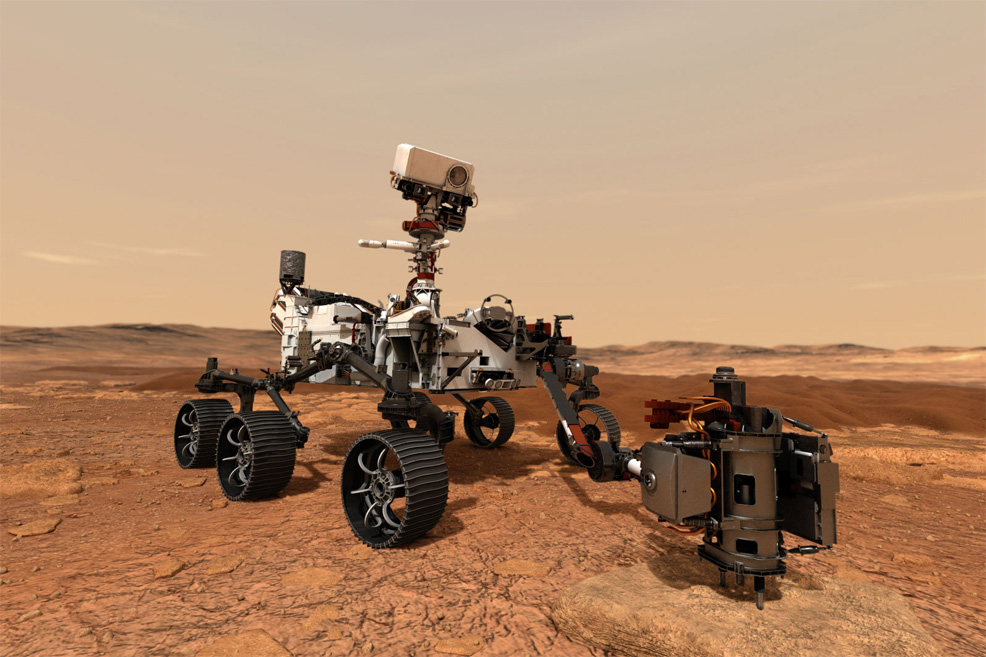
30th July 2020 NASA launches Mars 2020 rover mission The next Mars rover mission, Perseverance, is on its way to the Red Planet to look for signs of ancient life and collect samples for return to Earth.
The most sophisticated rover ever developed by NASA blasted off today at 7:50 a.m. EDT (4:50 a.m. PDT) on a United Launch Alliance (ULA) Atlas V rocket from Cape Canaveral in Florida. The Atlas V's Centaur upper stage initially placed the Mars 2020 spacecraft into a parking orbit around Earth. The engine fired for a second time and then the spacecraft separated from the Centaur as expected. Navigation data indicate the craft is perfectly on course to Mars. "With the launch of Perseverance, we begin another historic mission of exploration," said NASA Administrator Jim Bridenstine. "This amazing explorer's journey has already required the very best from all of us to get it to launch through these challenging times. Now we can look forward to its incredible science and to bringing samples of Mars home even as we advance human missions to the Red Planet. As a mission, as an agency, and as a country, we will persevere." The Perseverance rover's mission is to seek out signs of past microscopic life on Mars, explore the diverse geology of its landing site – Jezero Crater – and to demonstrate key technologies to help prepare for future robotic and human exploration. "Jezero Crater is the perfect place to search for signs of ancient life," said Thomas Zurbuchen, associate administrator for NASA's Science Mission Directorate at the agency's headquarters in Washington. "Perseverance is going to make discoveries that cause us to rethink our questions about what Mars was like and how we understand it today. As our instruments investigate rocks along an ancient lake bottom and select samples to return to Earth, we may very well be reaching back in time to get the information scientists need to say that life has existed elsewhere in the universe."
Jezero Crater is about 49 km (30.4 mi) in diameter and located slightly north of the Martian equator. Thought to have once been flooded with water, the crater contains a fan-delta deposit rich in clays. A lake in the crater was present when valley networks were forming on Mars, as seen in the artist's impression above. Besides having a delta, the crater shows point bars and inverted channels. From a study of the delta and channels, it was concluded that the lake did not experience times when the water went down. It probably formed with continual surface runoff. Life may therefore have developed in the crater since it is believed the lake was long-lived, and as deep as 250 m (820 ft). Perseverance will carry seven scientific instruments, including a Sample Caching System for picking up rocks and dust. The samples it collects on the surface could answer fundamental questions about the potential for life to exist beyond Earth. Two future missions by NASA, in collaboration with ESA, will work together to get the samples to an orbiter for return to Earth. When they arrive, the Mars samples will undergo in-depth analysis by scientists around the world using equipment far too large to send to the Red Planet. While most of the rover's instruments are geared toward learning more about the planet's geology and astrobiology, the MOXIE (Mars Oxygen In-Situ Resource Utilisation Experiment) will be focused on missions of the future. Its designers hope to demonstrate the conversion of carbon dioxide into oxygen, which could lead to subsequent versions of MOXIE technology that become staples on human missions, providing oxygen for rocket fuel and breathable air. Another major technology demonstration will be Ingenuity, the first helicopter on Mars. This small, robotic drone will scout interesting targets for study and help to plan the best driving route for Perseverance. The aircraft will be deployed from the rover's deck, and is expected to make five test flights during its 30-day period of activity, early in the mission. Each flight will last for about three minutes, at altitudes of up to 10 m (33 ft) above the ground, but it could potentially cover a maximum horizontal distance of about 600 metres (2,000 ft) per flight. It will use autonomous control and communicate with Perseverance directly after each landing. If the drone works as expected, NASA will build upon the design for future Mars missions. One day, it could potentially scout for human crews, investigating difficult-to-reach destinations, or transporting small payloads.
A total of 23 cameras are fitted at various points on the rover's body, providing a wide array of views and observation methods, from extreme close-up analysis to distant panoramas and zoom capabilities. Mastcam-Z, the main "eyes" of Perseverance, will spot features as small as a house fly from 100 m (328 ft) away and be capable of looking around in a full 360-degree circle. Two microphones will be used – during the landing event, while driving, and when collecting samples – revealing the sounds of an alien world. The mission duration is officially one Martian year (687 Earth days), but given the extreme longevity of previous Mars rover missions, it could last for a decade or more. "Perseverance is the most capable rover in history because it is standing on the shoulders of our pioneers Sojourner, Spirit, Opportunity, and Curiosity," said Michael Watkins, director of NASA's Jet Propulsion Laboratory in Southern California. "In the same way, the descendants of Ingenuity and MOXIE will become valuable tools for future explorers to the Red Planet and beyond." Although today's launch was successful, about seven cold, dark, unforgiving months of interplanetary space travel now lie ahead for the mission – a fact never far from the mind of the Mars 2020 project team. "There is still a lot of road between us and Mars," said John McNamee, Mars 2020 project manager at JPL. "About 290 million miles of them. But if there was ever a team that could make it happen, it is this one. We are going to Jezero Crater. We will see you there Feb. 18, 2021." A "fetch" rover for returning the samples is expected to launch in 2026. The landing and surface operations of this follow-up mission would likely take place in early 2029. The earliest return to Earth is envisaged for 2031.
--- Follow us: Twitter | Facebook | Instagram | YouTube
Comments »
If you enjoyed this article, please consider sharing it:
|








